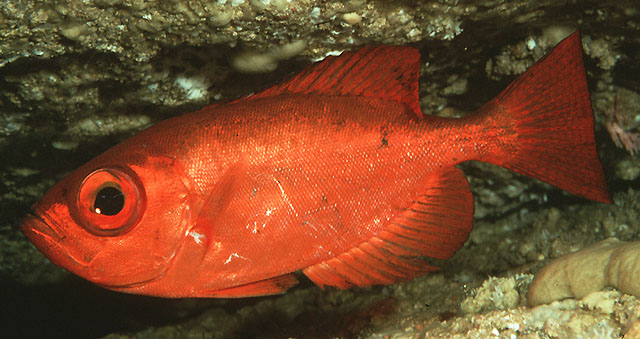| Priacanthidae (Bigeyes or catalufas) |
| 50.7 cm TL (male/unsexed); max.weight: 2,725.0 g |
|
reef-associated; marine; depth range 3 - 300 m |
| Atlantic and SW Indian Ocean: restricted. Former circumglobal distribution now accounted to former synonyms H. carolinus (widespread in the Indo-Pacific region) and H. fulgens (northeastern Atlantic Ocean). |
|
Dorsal spines (total): 10-10; Dorsal soft rays (total): 12-13; Anal spines: 3-3; Anal soft rays: 13-14. Silvery pink, mottled red or solid red in color; median fins with faint dark dots. Pelvic fins dusky or pale and without distinct spots (Ref. 4328). Section of preopercle behind canal striated and without scales (Ref. 26938).
Description: Characterized by the following: well developed preopercular spine, reaching nearly to posterior tip of subopercle; nearly symmetrical anterior profile; rounded caudal fin (Ref. 90102). |
| Common in lagoon and seaward reefs, primarily around islands. Under or near ledges by day (Ref. 9710). Benthopelagic (Ref. 58302). Juvenile pelagic (Ref. 9335). Nocturnal (Ref. 5213), feeding mainly on octopi, pelagic shrimp, stomatopods, crabs, small fish, and polychaetes. Solitary (Ref. 5213). During the day usually occurs singly or in small groups but at dusk it may gather in large numbers (Ref. 37816). Known to produce sound. Marketed fresh (Ref. 3800). Minimum depth reported taken from Ref. 30874. |
|
Least Concern (LC); Date assessed: 29 January 2013 Ref. (130435)
|
| reports of ciguatera poisoning |
Source and more info: www.fishbase.org. For personal, classroom, and other internal use only. Not for publication.

